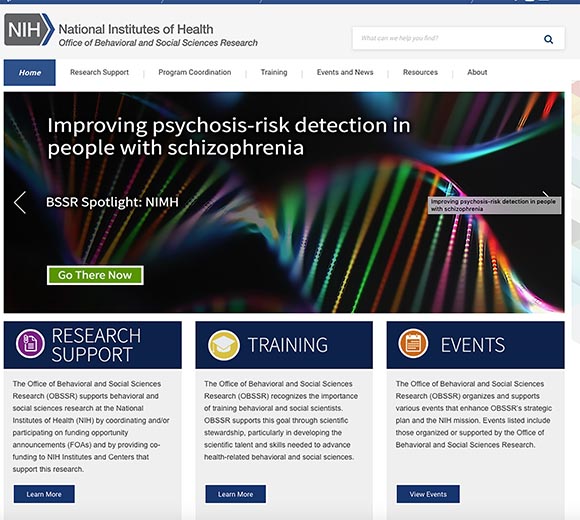News You Can Use
OBSSR Can Help with Your Behavioral and Social Sciences Research

Did you know that the Office of Behavioral and Social Sciences Research (OBSSR) is a resource for coordinating behavioral and social sciences research (BSSR) at NIH? Your research might even fit our portfolio. BSSR includes research topics such as attention, learning, and memory; developmental processes; obesity; disease management (medical errors, adherence, provider-patient interactions); language and communication disorders; bio-psychosocial processes related to mental health; pain, injury, and disability (pathophysiology, functional impairments); sensation and perception; sleep disorders; social processes and determinants; stress, trauma, and resilience; and health and well-being.
The OBSSR is dedicated to enhancing, coordinating, and communicating health-related BSSR across both extramural and intramural programs at the NIH. These efforts include reaching out to investigators, enhancing communications efforts, offering opportunities for funding support, and highlighting intramural accomplishments in the behavioral and social sciences.
Listening Tour: OBSSR has begun a series of visits to intramural researchers, programs, and branches. This “listening tour” is designed for OBSSR staff to hear about issues and explore potential ways to provide support to behavioral and social sciences researchers and their projects. Challenges already identified in conducting BSSR include difficulty in finding expertise and collaborators and a lack of networking activities. OBSSR is exploring ways to assist by developing resources for identifying collaborators and creating “meet and greet” and other networking opportunities. If you are interested in having OBSSR associate director Wendy Smith meet with you or your team, contact OBSSRIRP@nih.gov.
Funding Support: OBSSR has participated in the NIH Bench-to-Bedside Program awards since 2009 and has funded an average of one award per year and provided bench-to-bedside support to several programs (https://cc.nih.gov/ccc/btb/). In addition, OBSSR has been able to provide some direct support to programs requesting assistance. Feedback from previously and currently supported IRP investigators has helped OBSSR understand what kinds of support can be most helpful.
“The OBSSR helped us in a fundamental fashion with our ‘Molecular Foundations of Human Pain’ program,” said NIH Clinical Center scientist Michael J. Iadarola. “This program is focused on understanding the human ‘nociceptome’ and all the genes expressed in sensory neurons related to transduction of painful stimuli, understanding human genetic disorders of pain sensation by including behavioral phenotyping, and identifying new non-opioid molecular targets for pain control. The aid of OBSSR was an immense and timely contribution that is deeply appreciated.”
OBSSR is developing a standardized process for intramural programs to request funding support. For more information or questions, email OBSSRIRP@nih.gov.
LISTSERV: To identify BSSR investigators and share information, OBSSR is creating a LISTSERV email list of NIH intramural behavioral and social sciences researchers and fellows. The goal is to be able to facilitate communication and dissemination of information such as activities, funding opportunities, and networking events. For information on the LISTSERV or how to join it, email OBSSRIRP@nih.gov.
To learn more about OBSSR, go to https://obssr.od.nih.gov. To arrange a visit as part of the OBSSR IRP listening tour, explore funding opportunities or other resources support, have questions answered, and get clarification as whether your program or research topics are related to BSSR, contact OBSSRIRP@nih.gov.
This page was last updated on Tuesday, March 29, 2022
